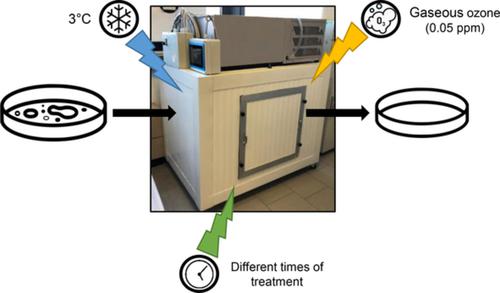当前位置:
X-MOL 学术
›
J. Food Saf.
›
论文详情
Our official English website, www.x-mol.net, welcomes your
feedback! (Note: you will need to create a separate account there.)
Impact of low-dose gaseous ozone treatment to reduce the growth of in vitro broth cultures of foodborne pathogenic/spoilage bacteria in a food storage cold chamber
Journal of Food Safety ( IF 1.9 ) Pub Date : 2021-02-17 , DOI: 10.1111/jfs.12892 Francesco Bigi 1 , Hossein Haghighi 1 , Andrea Quartieri 1 , Riccardo De Leo 1 , Andrea Pulvirenti 1, 2
Journal of Food Safety ( IF 1.9 ) Pub Date : 2021-02-17 , DOI: 10.1111/jfs.12892 Francesco Bigi 1 , Hossein Haghighi 1 , Andrea Quartieri 1 , Riccardo De Leo 1 , Andrea Pulvirenti 1, 2
Affiliation

|
Cold storage coupled with gaseous ozone represents a potential strategy to reduce or inhibit the presence of pathogenic and spoilage bacteria in a food storage cold chamber. This study aims to evaluate the impact of gaseous ozone treatment (0.05 ppm at exposure times of 30 and 60 min) on the bacterial contamination of internal surface and air in a cold chamber (3°C) intended for food storage. The bacterial load of internal surfaces was reduced by 0.99 ± 0.24 and 1.35 ± 0.27 log after 30 and 60 min ozone treatment, respectively. Airborne bacterial load was reduced by 0.93 ± 0.24 log after 30 min ozone treatment and became non-detectable after 60 min. Gaseous ozone treatments (0.05 ppm at exposure times of 1, 2, 6, 24, 30, and 48 hr) of the cold chamber were investigated to evaluate the effectiveness of this technology against Escherichia coli, Listeria monocytogenes, Salmonella enterica Typhimurium, Campylobacter jejuni, and Pseudomonas fluorescens cultured in broth cultures. Ozone treatment was effective against C. jejuni since the population at the highest concentration of inoculum (3.34 log CFU/plate) was reduced by 2.23 log after 1 hr and it was completely undetectable after 2 hr. S. enterica and E. coli showed the highest resistance to short ozone treatment since 6 hr treatment did not show antibacterial activity whereas after 24 hr treatment around 2 log reduction was observed for both pathogens. Short ozone treatment did not affect L. monocytogenes viability. P. fluorescens showed high sensitivity to short treatments, with 0.75–1.32 log reductions after 1 hr and further 0.22–0.53 log reductions after 6 hr.
中文翻译:

低剂量气态臭氧处理对减少食品储藏冷室中食源性致病菌/腐败菌体外肉汤培养物生长的影响
冷库与气态臭氧相结合代表了一种潜在的策略,可以减少或抑制食品冷藏室中致病菌和腐败菌的存在。本研究旨在评估气态臭氧处理(暴露时间为 30 和 60 分钟时为 0.05 ppm)对用于食品储存的冷室 (3°C) 内表面和空气的细菌污染的影响。在臭氧处理 30 和 60 分钟后,内表面的细菌负荷分别降低了 0.99 ± 0.24 和 1.35 ± 0.27 log。臭氧处理 30 分钟后,空气中的细菌负荷减少了 0.93 ± 0.24 log,60 分钟后变得不可检测。研究了冷室的气态臭氧处理(0.05 ppm,暴露时间为 1、2、6、24、30 和 48 小时),以评估该技术对在肉汤培养物中培养的大肠杆菌、单核细胞增生李斯特菌、鼠伤寒沙门氏菌、空肠弯曲杆菌和荧光假单胞菌。臭氧处理对空肠弯曲杆菌有效,因为最高接种浓度 (3.34 log CFU/板) 的种群在 1 小时后减少了 2.23 log,并且在 2 小时后完全检测不到。S. enterica和E.coli对短时臭氧处理显示出最高的抵抗力,因为 6 小时处理未显示抗菌活性,而在 24 小时处理后,两种病原体均观察到约 2 log 减少。短时间臭氧处理没有影响L. 单核细胞增生李斯特菌生存力。荧光假单胞菌对短期处理表现出高度敏感性,1 小时后降低 0.75-1.32 log,6 小时后进一步降低 0.22-0.53 log。
更新日期:2021-02-17
中文翻译:

低剂量气态臭氧处理对减少食品储藏冷室中食源性致病菌/腐败菌体外肉汤培养物生长的影响
冷库与气态臭氧相结合代表了一种潜在的策略,可以减少或抑制食品冷藏室中致病菌和腐败菌的存在。本研究旨在评估气态臭氧处理(暴露时间为 30 和 60 分钟时为 0.05 ppm)对用于食品储存的冷室 (3°C) 内表面和空气的细菌污染的影响。在臭氧处理 30 和 60 分钟后,内表面的细菌负荷分别降低了 0.99 ± 0.24 和 1.35 ± 0.27 log。臭氧处理 30 分钟后,空气中的细菌负荷减少了 0.93 ± 0.24 log,60 分钟后变得不可检测。研究了冷室的气态臭氧处理(0.05 ppm,暴露时间为 1、2、6、24、30 和 48 小时),以评估该技术对在肉汤培养物中培养的大肠杆菌、单核细胞增生李斯特菌、鼠伤寒沙门氏菌、空肠弯曲杆菌和荧光假单胞菌。臭氧处理对空肠弯曲杆菌有效,因为最高接种浓度 (3.34 log CFU/板) 的种群在 1 小时后减少了 2.23 log,并且在 2 小时后完全检测不到。S. enterica和E.coli对短时臭氧处理显示出最高的抵抗力,因为 6 小时处理未显示抗菌活性,而在 24 小时处理后,两种病原体均观察到约 2 log 减少。短时间臭氧处理没有影响L. 单核细胞增生李斯特菌生存力。荧光假单胞菌对短期处理表现出高度敏感性,1 小时后降低 0.75-1.32 log,6 小时后进一步降低 0.22-0.53 log。











































 京公网安备 11010802027423号
京公网安备 11010802027423号